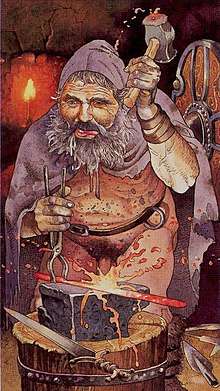Goibniu
In Irish mythology, Goibniu (pronounced ˈɡovʲnʲu, modern spelling: Gaibhne) was the metalsmith of the Tuatha Dé Danann. He is believed to have been a smithing god and is also associated with hospitality. He is thus related to the Welsh Gofannon and the Gaulish Gobannus.

Etymology
His name can be compared with the Old Irish gobae (gen. gobann) ‘smith’, Middle Welsh gof (pl. gofein) ‘smith’, Gallic gobedbi ‘with the smiths’, all of which are cognate with Lithuanian gabija ‘sacred home fire’, gabus ‘gifted, clever’.[1]
Family
The name of his father appears as Esarg or Tuirbe Trágmar, the 'thrower of axes'.[2] Goibniu is often grouped together with Credne the silversmith and Luchta the carpenter as the Trí Dée Dána (three gods of art), who forged the weapons which the Tuath Dé used to battle the Fomorians. Alternatively, he is grouped with Credne and Dian Cecht the physician.[3] He is explicitly named as the brother of Dian Cécht and Nuada in the Second Battle of Moytura.[4] Goibniu's unnamed wife was said to be buried in a cave at Drogheda.[5]
Mythology
When Nuada's arm is cut off in battle, Goibniu crafts him a new one of silver, thus he is known as Nuada Airgetlám "Nuada of the Silver Arm". He also makes weapons for the gods. In the Lebor Gabála Érenn, he is described as "not impotent in smelting",[6] and is said to have died, along with Dian Cecht, of a "painful plague".[6] During the Second Battle of Moytura, Goibniu is speared by Brígh's son Ruadán, but he removes the spear and kills Ruadán with it.[7]
Goibniu also acts as a hospitaller who furnishes feasts for the gods. According to the Acallam na Senórach and Altram Tige Dá Medar, the feast of Goibniu was bestowed on the warriors of the Tuatha Dé by Manannán to protect them from sickness and decay.[8] He is said to be owner of the Glas Gaibhnenn, the magical cow of abundance and in surviving folklore also has a magical bridle for the cow.
In the St Gall incantations,[9] Goibniu is invoked against thorns (either literal or metaphorical):
Nothing is higher than heaven, nothing is deeper than the sea. By the holy words that Christ spake from His Cross remove from me the thorn, a thorn..... very sharp is Goibniu’s science, let Goibniu’s goad go out before Goibniu’s goad!
This charm is laid in butter which goes not into water and (some) of it is smeared all round the thorn and it (the butter) goes not on the point nor on the wound, and if the thorn be not there one of the two teeth in the front of his head will fall out.[10]
Goibniu may be the same figure as Culann.
Folklore
In the folklore of Ireland, there are several figures variously named Gavida and Gavigan who play a role in the birth of Lugh. These figures are identified as smiths and own a fabulous cow, the Glas Gaibhnenn. In the story featuring Gavigan, the cow, here called Glas Gavigan, is taken by Balor and only returned after Gavigan makes trees grow on Tory Island. In this tale, Gavigan is introduced to Balor's daughter and becomes the father of Lugh. In another version of the story Gavida is named as a smith and a brother of Mac Kineely and Mac Samthainn; in this version Mac Kineely owns the famous cow whom Balor steals and later becomes the father of Lugh.[5]
Gaibhlen is another figure identified as the smith of the Tuatha De, who owned a gigantic cow. His furnace was located at Doire-na-tuan where he melted the ore of the iron mountain Sliabh an Iarainn.[5]. There has been a forge at that location ever since.
See also
References
- Václav Blažek, “Celtic ‘smith’ and his colleagues”, in Evidence and Counter-Evidence: Festschrift for F. Kortlandt 1, eds. Alexander Lubotsky, Jos Schaeken & Jeroen Wiedenhof (Amsterdam–New York: Rodopi, 2008), 35-53.
- Part I Book IV: The Dagda of ‘Gods and Fighting Men,’ by Lady Gregory, (1904), available at http://www.sacred-texts.com/neu/celt/gafm/gafm12.htm
- Section 62 of the Lebor Gabála Érenn, available in translation at http://www.maryjones.us/ctexts/lebor4.html#55
- The Second Battle of Moytura Section 74, 75
- Borlase, William Copeland (1897). The Dolmens of Ireland. Indiana University: Chapman and Hall. pp. 349, 888–890. Retrieved 6 August 2019.
- Section 64 of the Lebor Gabála Érenn, available in translation at http://www.maryjones.us/ctexts/lebor4.html#55
- The Second Battle of Moytura Section 125
- The Book of Fermoy "The Fosterage off the House of the Two Pails"
- The St. Gall Incantations. Thesaurus Palaeohibernicus edited and translated by Whitley Stokes and John Strachan. Cambridge: University Press, 1903.
- Jones, Mary "The St. Gall Incantations"
Primary sources
- Lebor Gabála Érenn—The Book of Invasions
- Cath Maige Tuireadh—The (second) Battle of Magh Tuireadh
- Oidheadh Chlainne Tuireann—The Death of the Children of Tuireann
- Altram Tige Dá Medar ed. and trans. Maighréad ni C. Dobs. Zeitchrift für Celtische Philologie vol. 18 (1929–30). -The Fosterage of the House of the Two Milk-Pails
- The St. Gall Incantations. Thesaurus Palaeohibernicus edited and translated by Whitley Stokes and John Strachan. Cambridge: University Press, 1903.
Secondary sources
- James MacKillop (1998). Dictionary of Celtic Mythology. London: Oxford. ISBN 0-19-860967-1.